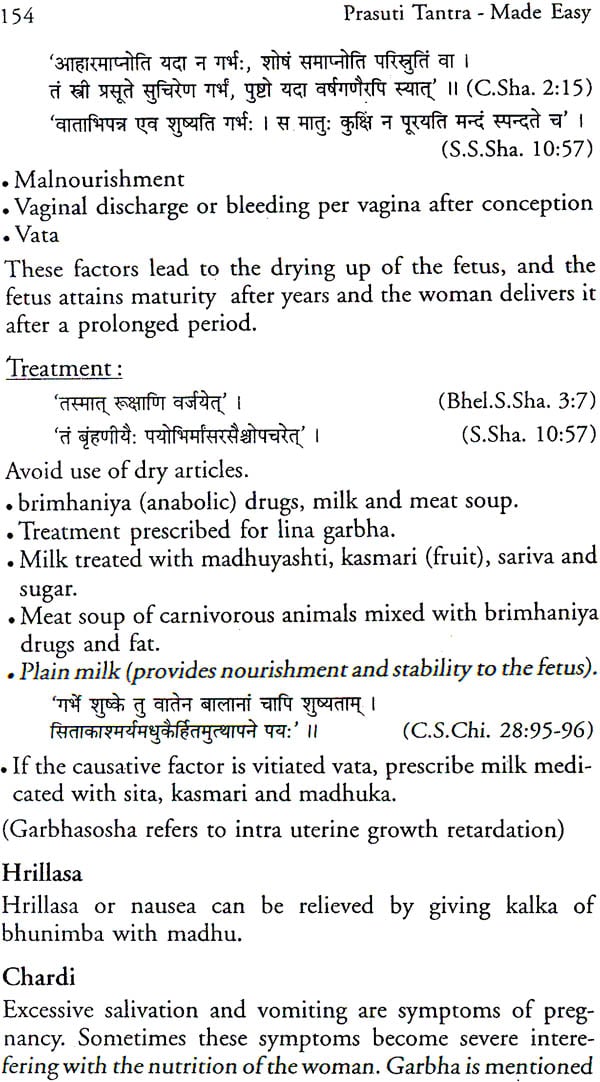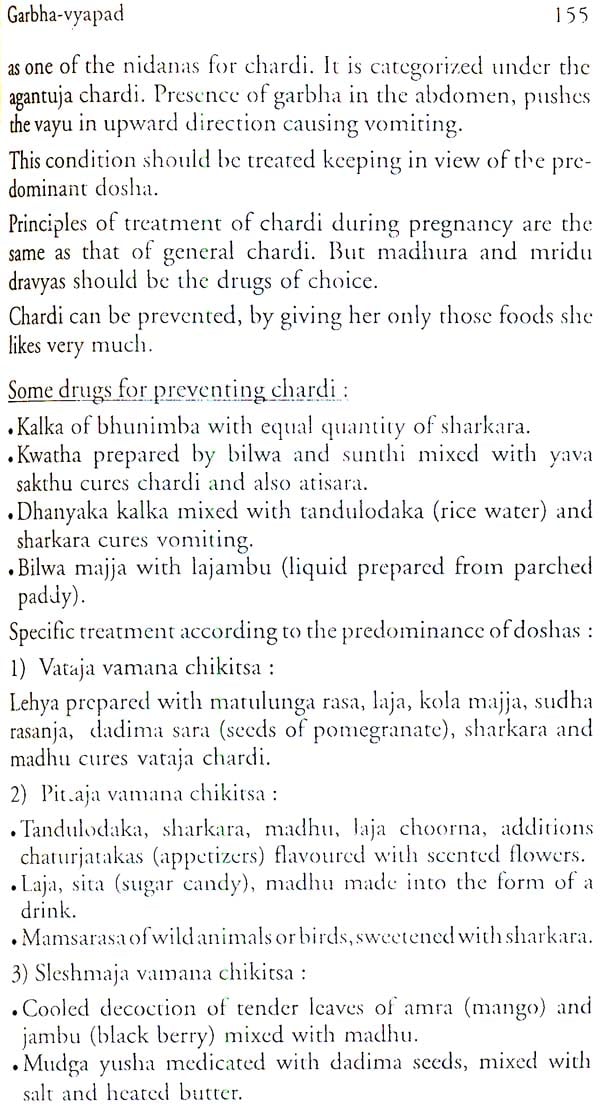
Prasuti-Tantra Made Easy (According to The Syllabus of CCIM, New Delhi)
Book Specification
| Item Code: | NAJ227 |
| Author: | Dr. Gayatri Devi |
| Publisher: | Chaukhamba Sanskrit Pratishthan |
| Language: | English |
| Edition: | 2018 |
| ISBN: | 9788170843673 |
| Pages: | 384 (110 B/W Illustrations) |
| Cover: | Paperback |
| Other Details | 8.5 inch X 5.5 inch |
| Weight | 370 gm |
Book Description
About the Author
“Prasuti Tantra Made Easy” is an attempt to meet the requirements of the students of Ayurvedic medicine, both at graduate and post-graduate levels. The book has been written keeping in view the syllabus framed in various universities in India and the requirements of the students.
Accordingly, the book is organized into chapters, each chapter coveting an important topic of the subject. The book is written in a very simple and lucid style to make the understanding of the topics easy. It also gives, to the extent required and feasible, a brief introduction to similar topic in modem obstetrics. Model papers for MD entrance are appended.
The book will no doubt, be useful to the students to do well in the examinations. It is also expected to be useful to the practitioners.
About the Author
Dr. Gayatri Devi has been practicing Ayurveda for more than two decades, with special focus on Stree Roga. She has been successfully handling several infertility cases not only in major cities like Chennai, Hyderabad and Mumbai in India but also far of countries like US, Australia and Singapore.
She has received national award from directorate of adult education, government of India for her book on antenatal care in 1984, just after completion of her degree in Ayurveda from Nagarjuna University, Vijayawada. Since then, she has been contributing immensely in the field of Stree Roga through regular features in journals, interviews over TV and books. She is a national awardee for two times for her booklets on Ayurveda from Children’s Book Trust.
She has been writing books on Ayurveda both in English and Telugu. Her earlier book in English, “Padartha Vijnana Made Easy” has been very useful to the students of Ayurveda. Her recent book in Telugu on women’s health is proving to be quite useful to women of all ages, in various stages of their lives.
She has been awarded “Adarsha Vanitha Pwaskar” For her service to the society through Ayurveda.
Preface
Books on different subjects are written in different ways. Writing of the books in different periods of time are written in different styles.
Ayurvedic Samhitas were written several hundreds of years back. They were written in a different: style, which is very much different from today’s style of writing. In comparison with today’s text books on medicine, they do not look like well organized books. The reason is well known. In those days students were not taught through books. Sishyas used to be with their Gurus always and gurus kept explaining various points to sishyas at anytime convenient to them. Whenever a sishya got a doubt, it was clarified to him by guru then and there. Some times they used to have a discussion on a particular topic and drew conclusions. It was only later that some of the sishyas attempted to compile notes based on discourses and discussions in an organized way. They tried to bring some order while compiling their learning into Samhitas. Yet, we find that many of the Samhitas were not organized into chapters covering topics and unless we read all shlokas in the Samhitas from beginning to end, we will not be in a position to know which topic is covered in which chapter.
There is no doubt that the best way of gaining knowledge is reading the original Samhitas. But for various reasons, it is difficult to read and understand the originals. As the topics are not arranged in a sequence that is followed today, students of Ayurvedic medicine may find it all the more difficult to read them. Therefore, they may require text books to help them to understand the topics. They can refer to the original Samhitas after getting a clear understanding of the topics from the text books written keeping in view the requirements of students and their syllabus.
When we talk about Ayurvedic anatomy, obstetrics and gynecology you don’t find all the relevant topics covered in one chapter of a Samhita or for that matter even in one Samhita. You don’t find the detailed anatomical description of any organ or system of the body as in the case of modern text books. All such descriptions are very brief and given in sutra form in Ayurveda. Quite often there may not be any description at all.
As an author of this book, “Prasuti Tantra - Made Easy”, I am attempting to present all the topics in a sequence which is going to be useful to Ayurvedic students. I have taken into account the syllabus of various Ayurvedic medicine courses in the country and also the present requirements of the students.
I did not attempt to compare the Ayurvedic description and terminology with that of the modern science. I did not feel the need to compare and show that whatever is described in modern science is present in the ancient texts. I assume that, this is not the need of the time. People all over the globe are appreciating the importance of Ayurveda in the health care system. Now what we have to do is to show the world that our ancient treatments and diet restrictions are time tested and prove to be result oriented even today.
The contents of the Samhitas are presented in the order and in accordance with your syllabus. Modern description helps you in understanding properly whatever is there in the ancient texts in Sutra form. Therefore a brief description of the same topic are given as per modern science. Wherever modern anatomical terminology can be clearly given along with ancient text, I presented the same for clear understanding.
I hope this book will be helpful to you to get through your exams successfully and also for your practice in future. In case some of you want to pursue further in academic line must go to the original texts and try to understand them.
Suggestions are welcome from all of you, to make this book more useful in future.
Introduction
Ayurveda is also known as ‘Asthtanga Ayurveda’, There are eight branches in this Science of life. These eight branches are 1. Kayachikitsa (internal medicine), 2. Shalya tantra (surgery), 3. Shalakya tantra (disease of the organs in the head & neck region), 4. Agadatantra (toxicology), 5. Bhutavidya (Psychiatry), 6. Kaumarabhritya (Paediatrics), 7. Rasayanatantra (Rejuvination therapy) & 8. Vajikarana tantra (Science of fertylity and virility). Prasutitantra is not mentioned separately in these eight branches. But all the Samhitas described various aspects of the formation and development of garbha, various possible garbha vyapats and their management, management of prasava, care of the sutika and so on in detail. These descriptions are not given under the heading of Prasuti tantra. But Prasuti tantra was not neglected by them. Prasuti is included under the name Kaumarabhritya.
The names Prasuti tantra and Stree roga are coined separately in recent times on par with the branches of modern medicine - obstetrics and gynaecology.
The Sanskrit word ‘prasava’ means giving birth or producing or expelling garbha. Tantra means science. Prasuti tantra is the scientific knowledge of conception, growth of the fetus, delivery of the fetus, care of the mother and child after delivery.
Obstetrics is defined as the branch of medicine that deals with the care of the pregnant woman during the gestation period, parturition and puerperium.
Contents
| Chapter 1 | Stree Sharia Vijnan | 5-28 |
| Chapter 2 | Rajovijnan | 29-46 |
| Chapter 3 | Garbha Vijnan | 48-98 |
| Chapter 4 | Garbhini Vijnana | 101-115 |
| Chapter 5 | Garbha-vyapad | 118-183 |
| Chapter 6 | Garbhini Vyavastha | 184-208 |
| Chapter 7 | Prasava Vijnana | 210-237 |
| Chapter 8 | Prasava-vyapad | 238-265 |
| Chapter 9 | Sutika Vijnan | 267-294 |
| Chapter 10 | Stanya Vijnan | 295-303 |
| Chapter 11 | Parivar Kalyana | 305-322 |
| Chapter 12 | Mudhagarbha | 324-338 |
| Appendix 1 | Yoga & Exercise | 339 |
| Appendix 2 | Obstetric Instruments | 347 |
| Appendix 3 | Herbs Used in Prasuti-tantra | 356 |
| Appendix 4 | Multiple Choise Questions | 372 |
| Appendix 5 | Paribhashik Shabda | 382 |
|
| Bibliography | 384 |







